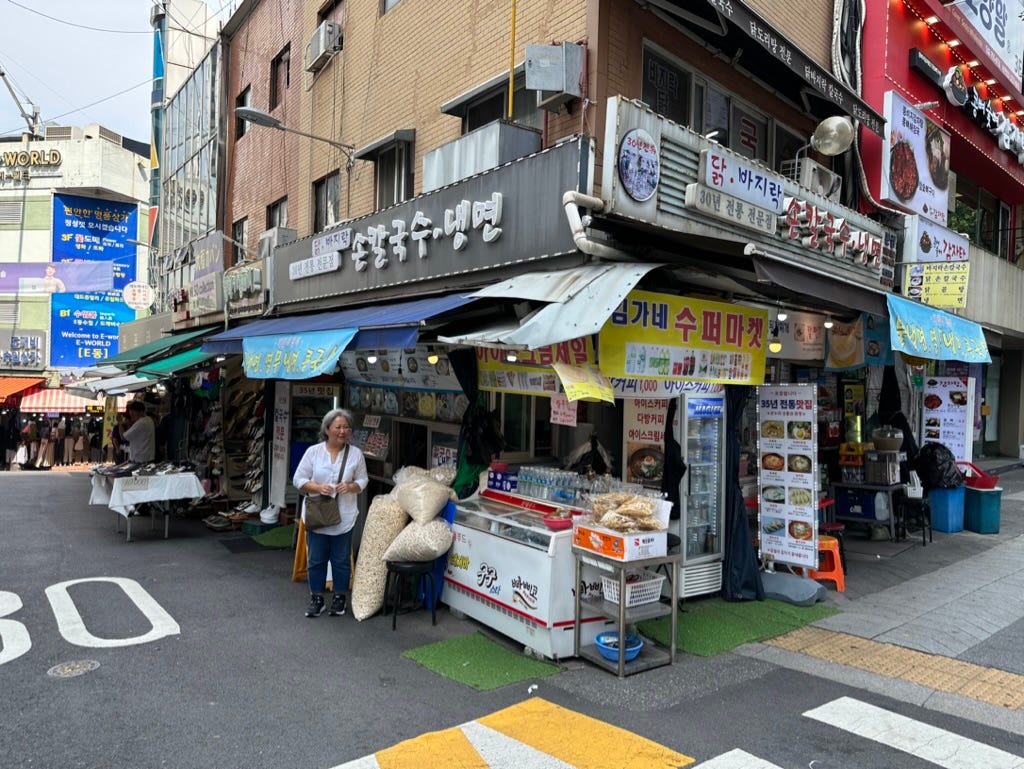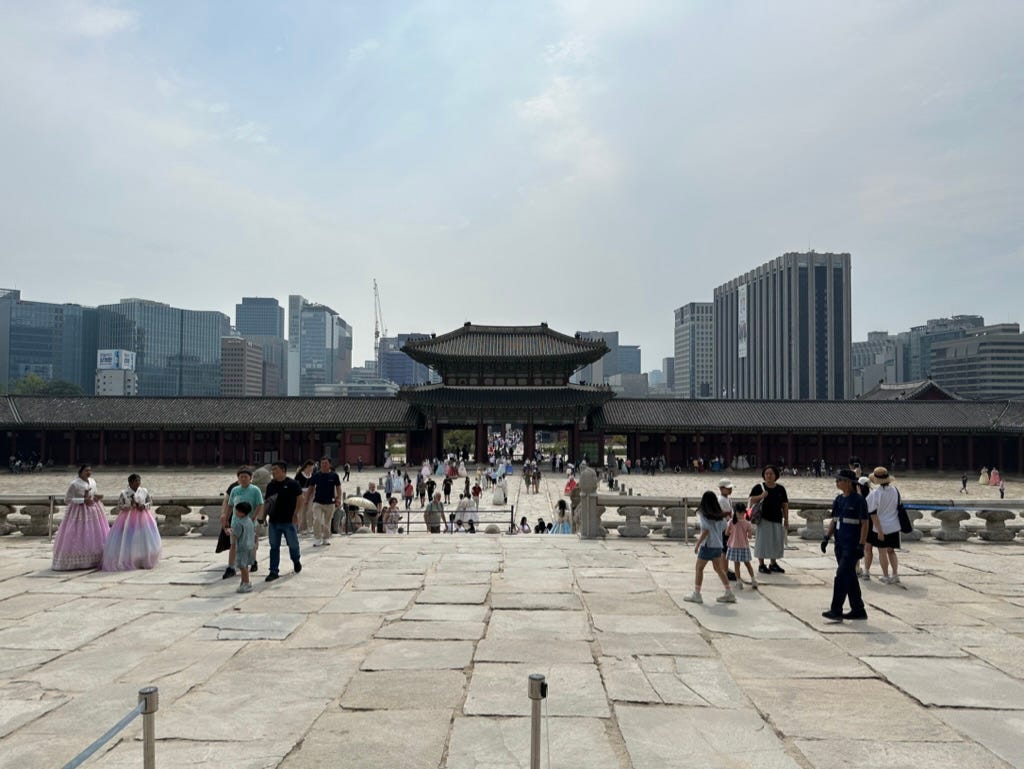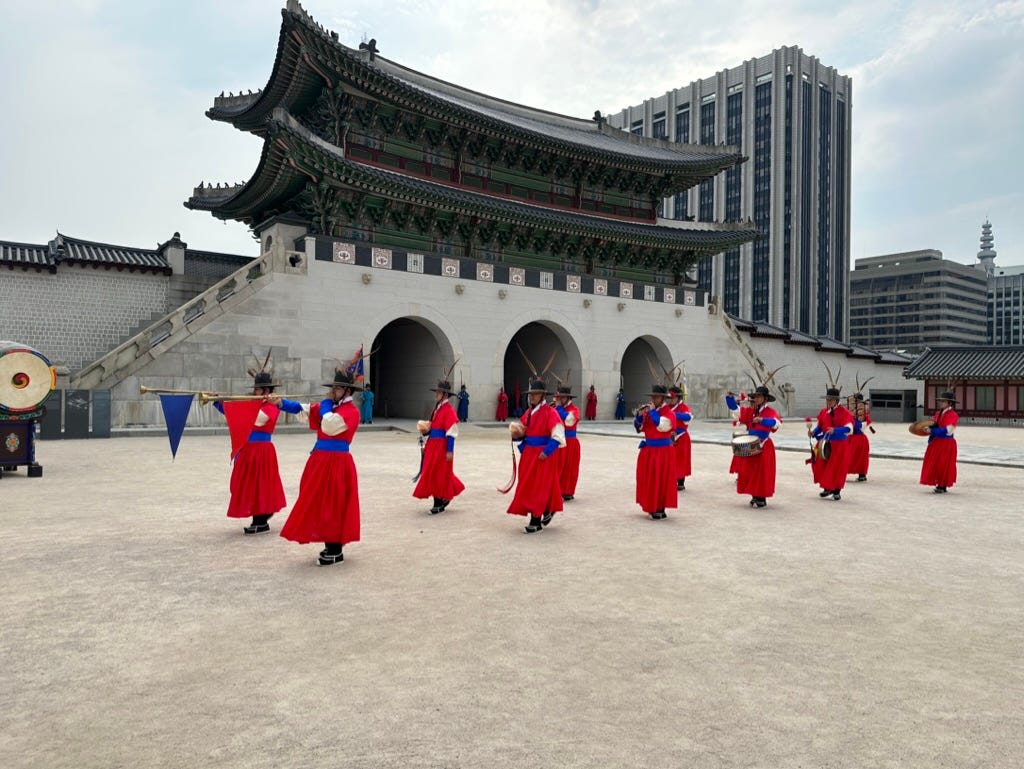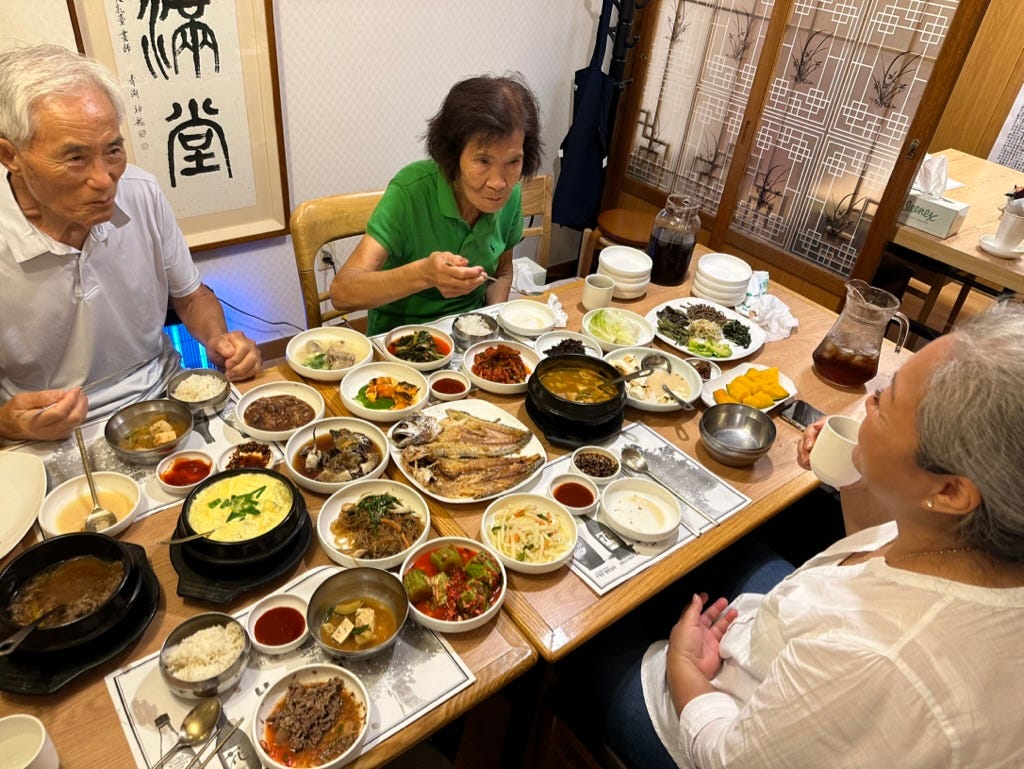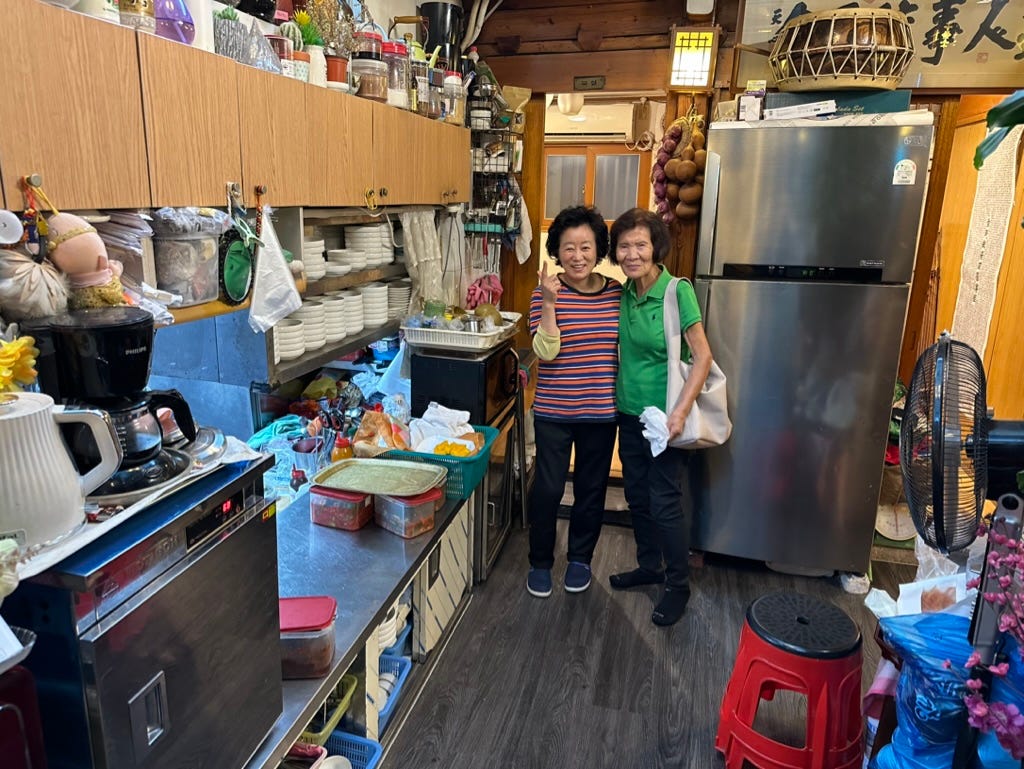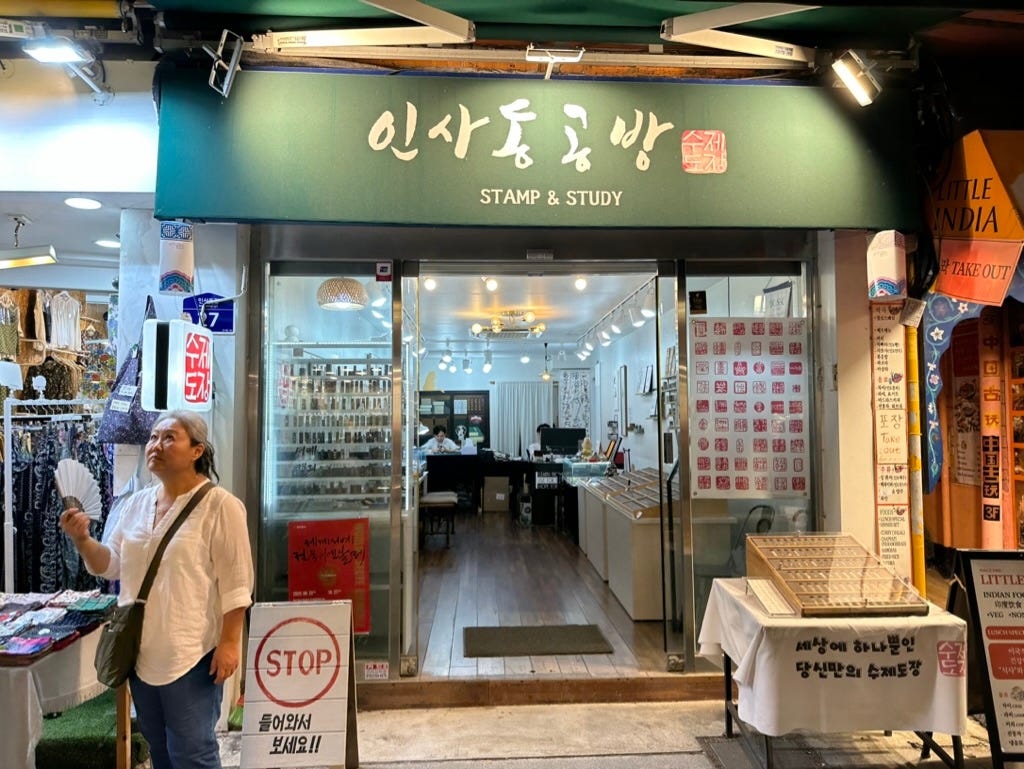South Korea - Chapter 3: Some journeys take days, some days are a journey
My favorite days are those that lead to a destination you couldn’t have imagined when you rolled out of bed that morning. We started by heading back to Namdaemun Market to get an early lunch. The place we chose was very small with only 4 tables and in what is becoming a pattern, an even smaller staff. The entire restaurant was run by just a single person. The food was quite good and the entire staff was friendly.
Our primary activity for today was a place we already knew we were going: Gyeongbokgung Palace. The Korean peninsula was ruled as a kingdom from the 7th century BCE until 1910 when Imperial Japan invaded and occupied Korea. My in-laws were just kids during the occupation but they remember being told they were now no longer Korean but Japanese and were taught to speak Japanese. Eventually the Japanese were forced out and when the armistice was signed in 1953, South Korea became a country represented by the people.
Gyeongbokgung Palace was the home of the various kings of Korea over many centuries. It sits at what is now the northern edge of Seoul. The juxtaposition of the mountains behind it and the modern buildings of Seoul in front of it, was not lost on me. Even the Blue House (where the President of South Korea resides), it visible nearby.
When Imperial Japan invaded, they burned down most of the palace. Clearly they had no sensitivity to its cultural value. That I guess should be no surprise given that they were attempting to erase Korean culture entirely. As horrific as the dropping of two atomic bombs on Japan was, the United States at least made the conscious decision to not consider Kyoto as a target because it is home to so many ancient Japanese temples that the Japanese cultural consultant hired to provide advice on targets said that to bomb Kyoto would be a crime against humanity.
The palace was eventually rebuilt to appear just as it had for so many centuries. It’s a big place. If you come dressed in a hanbok (a traditional Korean outfit), you are admitted free of charge and thus people dressed in the colorful clothing can always be seen there.
We stayed for the changing of the guard which is done every hour on the hour apparently.
Being out in the sun all afternoon combined with walking thousands and thousands of steps before lunch was a bit tiring. We took a break in the cafe that is connected to the gift shop on the property where, for the second time since we arrived in South Korea five days ago, my Mother-In-Law ran into someone she knows from the small town in which she and my Father-In-Law live: Killeen, Texas.
It was now time to head off to Insadong, an area in Seoul that my in-laws wanted to visit though it was unclear to me as to why. This is yet another part of Seoul that combines the new and the old. There are streets that are new, wide and filled with shops.
Turn down an alleyway and you can find yourself amongst streets filled with restaurants. While we were looking for a place to eat, we snaked through what felt like a near endless labyrinth of narrow alleyways. I could not understand why we were passing so many restaurants that looked quite suitable.
We ended up in an area of hanoks which are traditional Korean homes. Then just when I thought my legs could carry me no further, my Mother-In-Law announced that we had arrived at our destination: a restaurant named Su Yuen which occupied one of the better preserved hanoks.
Rather than enter though that massive wooden door, you instead enter through a side door. I suppose because the owners wish it to continue to feel like a home, you take your shoes off when you enter. It’s made up of six private dining rooms with the kitchen smack-dab in the middle.
I wasn’t really sure what I was in for until Jeannie looked at me with a smile and said, “This is going to be an experience.” I didn’t really notice that we had actually ordered any food. Instead you order your meal as a group in sizes small, medium or large. A few minutes later, dishes began appearing. When the table seemed full, I took a picture of the meal we were about to have. We started eating but then more dishes arrived so I took a second picture. A few minutes later more dishes were delivered. In the end, the medium meal we ordered, the cost of which was $42USD per person, totaled 30 unique dishes.
It was truly an epic meal. I asked my Mother-In-Law how she knew about this place. She told me that she remembered one like it from when she was a teenager. When we arrived in the area, she asked a few people if there was such a restaurant and while all confirmed there was, not one could provide a name or location. Given how well-hidden this restaurant is, that’s unsurprising. That their business card has detailed instructions on how to find it once you in the area tells you all you need to know. And like the small hole-in-the-wall where we had lunch in Itaewon the other day, Su Yuen appeared to have a staff of just two. That by itself seems miraculous.
Around 24 years ago, not long after I met Jeannie, I had a meal with her and her parents at their house. When I was finished eating, Jeannie’s mom asked her in Korean if I didn’t like the food. Apparently that was the only explanation she could come up with to explain why I had stopped while the rest of them continued on for some time. Later when I remarked at this, Jeannie explained that, “Koreans love to eat.” I suggested that everyone loves to eat. “Not like Koreans”, she said. I have come to understand exactly what that means. They are truly in a class by themselves.
They continued eating at Su Yuen long after I had finished. As we were leaving, I snapped a picture of 50% of the staff (the woman on the left) and my Mother-In-Law standing in the middle of the kitchen which, as I mentioned earlier, is essentially the hub of the restaurant as you must go through it to get to any of the private dining rooms. Stuffed to the gills, we left quite satisfied. Jeannie’s mom made sure to get a business card as she’s already looking forward to our future second meal at Su Yuen before we leave South Korea.
As the darkness of evening fell, Insadong began to light up as crowds of people filled the streets to shop and eat. We needed to walk off a bit of our meal so we joined in. After watching a local street performer work his way out of a straight jacket and chains, we came across a store that sold something that was on my personal list for this trip. I wanted my own name chop.
In some Asian countries, official documents are often not signed with a pen but instead with an inked stamp. That’s just what this shop does exclusively.
It’s run by two brothers that look like they could almost be twins. One handles the customers and the other creates the chops. I spend some times looking through the wide variety of options before choosing one.
Because the year in which I was born was the year of the dragon, I chose a stamp with a golden dragon on it. Though traditionally the names on these stamps are in Chinese (yes, even for Koreans and Japanese), I wanted mine in Korean. Having chosen the stamp itself and working with sales brother on how my name in Korean would appear, I watched as his brother hand-carved my unique name chop. He then stamped a card with it, sprinkled the ink with gold dust and used a lighter to melt the dust into the card.
The packaging came with a cloth case for the stamp and I bought some ink as well. It will definitely be my favorite souvenir of this trip. Just shy of 14,000 steps taken today made it exhausting but it was certainly a memorable day that ended in ways I could not have imagined.



